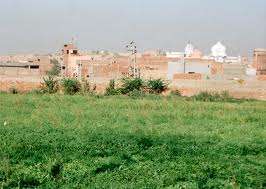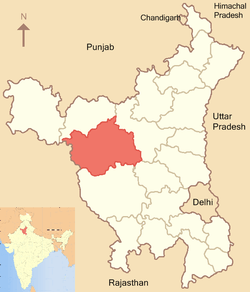Agroha Mound
 Ther Mound | |
 Shown within India | |
| Alternate name | Excavated Site at Haryana State |
|---|---|
| Location | Agroha, Haryana, India |
| Coordinates | 29°33′15″N 75°37′18″E / 29.55417°N 75.62167°ECoordinates: 29°33′15″N 75°37′18″E / 29.55417°N 75.62167°E |
| Type | Settlement |
| History | |
| Founded | 3rd to 4th century BC |
| Abandoned | 13th to 14th century AD |
| Site notes | |
| Excavation dates | 1888–1889, 1978–1979 |
| Archaeologists | C. T. Rogers, J. S. Khatri, Acharya |
Agroha, locally known as Ther, is an archaeological site, located in Agroha in Hisar district of India. It was once the capital of Agrasena.
Location
The mounds are located about 1.5 km from the town of Agroha, 20 km from Hisar city and 190 km from New Delhi in Hisar district of Haryana, India.[1] It lies on National Highway 10.
Rediscovery and excavation
The excavations first started in the year 1888-89 under C.T. Rogers.[2] It restarted in the year 1978-79 by Archaeological Department of Haryana under the supervision of J.S. Khatri and Acharya.[3]
Mythology
Members of the Agrawal caste claim that the archaeological findings are related to their legendary founder — the king Agrasena, whose capital is said to have been at Agroha. The Agrawal organizations such as Akhil Bharatiya Agrawal Sammelan and Agroha Vikas Trust have supported archaeological research at the site.[4]
Historical significance

According to the official website of Hisar, the excavations at Agroha belong to the period from 3rd-4th century B.C. to 13th-14th century A.D. Defense wall, shrine cells and residential houses can be observed in the mound.[5]

Notable artifacts
Around seven thousand artifacts have been recovered during the excavations.
Coins
Silver and bronze coins belonging to different periods have been found at the site. They belong to Roman, Kushana, Yaudheya and Gupta empire. Language used is Prakrit.[6]
Seals
A large number of seals have also been found. They are inscribed with words like Pitradutt, " Sadhu Vridhasya", "Shamkar Malasya", "Madrsya", etc.[7]
Others
Besides a large number of stone sculptures, iron and copper implements and beads of semi-precious stones have also been found.[8]
See also
References
- ↑ http://www.haryana-online.com/agroha.htm
- ↑ http://www.agroha.com/agrdham.htm
- ↑ http://asi.nic.in/asi_exca_indi_haryana.asp
- ↑ Babb 2004, p. 186.
- ↑ http://hisar.nic.in/historyhisar.aspx
- ↑ http://www.agroha.com/introduction.html#maharaj
- ↑ http://www.agroha.com/introduction.html#maharaj
- ↑ http://hisar.nic.in/historyhisar.aspx
Bibliography
Babb, Lawrence A (2004). Alchemies of Violence: Myths of Identity and the Life of Trade in Western India. Sage. ISBN 978-0-7619-3223-9.
| ||||||||||||||||||||||||||||||||||||||||||||||||||||||||||||||

